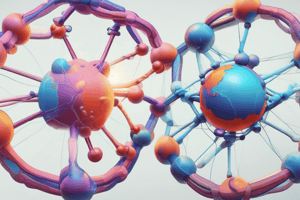Podcast
Questions and Answers
What factors contribute to a dipole moment in a molecule?
What factors contribute to a dipole moment in a molecule?
- Molecular size and electron configuration
- Atom weight and molecular shape
- Electronegativity difference and atom radius (correct)
- Temperature and pressure conditions
Which of the following interactions occurs between polar molecules?
Which of the following interactions occurs between polar molecules?
- Ionic interactions
- London Dispersion Forces
- Dipole-dipole interactions (correct)
- Covalent bonding
What is the primary reason for the strength of hydrogen bonding?
What is the primary reason for the strength of hydrogen bonding?
- The concentration of positive charge on hydrogen (correct)
- The presence of multiple hydrogen atoms in a molecule
- The ability to induce dipoles in non-polar molecules
- The large size of hydrogen atoms
Which term describes solvents that can form hydrogen bonds with themselves?
Which term describes solvents that can form hydrogen bonds with themselves?
What effect does increased branching in a molecule have on boiling point?
What effect does increased branching in a molecule have on boiling point?
Which type of force is associated with non-polar molecules that can induce transient dipoles?
Which type of force is associated with non-polar molecules that can induce transient dipoles?
Why does a large atomic radius contribute to a greater dipole moment?
Why does a large atomic radius contribute to a greater dipole moment?
What type of bond occurs primarily between hydrogen and the lone pair of NO?
What type of bond occurs primarily between hydrogen and the lone pair of NO?
Flashcards
Molecular Polarity
Molecular Polarity
Describes the uneven distribution of charge within a molecule, creating a dipole moment.
Dipole Moment
Dipole Moment
A measure of the polarity of a molecule; it arises from the difference in electronegativity between atoms.
Dipole-Dipole Forces
Dipole-Dipole Forces
Attractive forces between polar molecules, where opposite charges attract.
Hydrogen Bonding
Hydrogen Bonding
Signup and view all the flashcards
London Dispersion Forces (LDF)
London Dispersion Forces (LDF)
Signup and view all the flashcards
Intermolecular Forces
Intermolecular Forces
Signup and view all the flashcards
Protic Solvent
Protic Solvent
Signup and view all the flashcards
Aprotic Solvent
Aprotic Solvent
Signup and view all the flashcards
Study Notes
Molecular Polarity & Dipoles
- Dipole moment is the product of the difference in electronegativity and atomic radius.
- Larger atomic radius leads to a greater dipole moment due to increased distance for charge separation.
- C-heteroatom bonds have a dipole moment.
- Dipoles arise from induction and resonance.
Intermolecular Forces
- Neutral molecules are attracted by dipole-dipole interactions, hydrogen bonding, and London Dispersion Forces (LDF).
- Dipole-dipole forces occur when polar molecules line up with their opposite charges, increasing the boiling point (BP).
- Hydrogen bonding is a strong dipole-dipole force occurring between hydrogen and highly electronegative elements like N, O, or F. Strong hydrogen bonding leads to higher BP.
- Protic solvents participate in hydrogen bonding, while aprotic solvents do not.
- London Dispersion Forces (LDF) are weak forces created by temporary dipoles forming in nonpolar molecules.
- Increasing surface area (SA) leads to stronger LDF and higher BP.
London Dispersion
- London Dispersion Forces (LDF) originate from temporary dipoles in nonpolar molecules.
- Larger atoms/molecules have more electrons and larger surface areas, leading to stronger LDF.
- Higher surface area usually correlates to a higher boiling point (BP).
- Branching in a molecule decreases surface area and thus weakens LDF, leading to a lower BP.
Studying That Suits You
Use AI to generate personalized quizzes and flashcards to suit your learning preferences.




